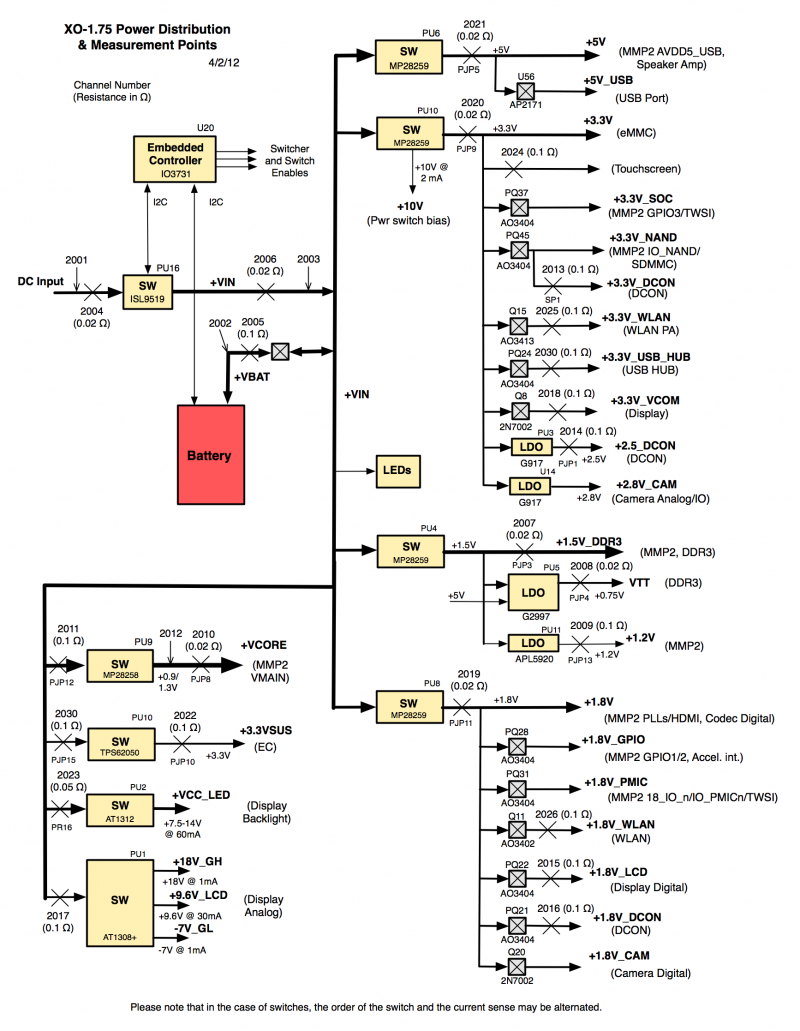XO1.75 Tinderbox Power
This page describes the Tinderbox version of the XO-1.75 C2 laptop.
Contents
Power Distribution
The following diagram attempts to illustrate the XO-1.75 power distribution network, as well as the tinderbox measurement points:
Measurement Points
There are two types of measurement point in the above diagram. Most measure power passing through a particular point in the power distribution network, and are represented by a large X, along with an annotation of the voltmeter channel and measurement resistance. All measurement resistors have a tolerance (variation in resistance) of 1% or smaller.
A smaller number of points (2001, 2002, 2003, 2012) measure the voltage at a particular point in the power network. These are indicated by an arrow, and annotated solely with the voltmeter channel.
The definitive file describing this setup is the tinderbox configuration file.
Example Measurements
Example readings taken using this setup are available at http://dev.laptop.org/~wad/cl2_c2/. Some of these measurements are highlighted below.
Measurement Error
It should be cautioned that using a multiplexed voltmeter for measurement of power in a dynamic system has its downsides.
Laptop Off
When the laptop is off, the power measurements are quite low.
If DC power is supplied, but no battery is charging, the laptop takes a surprising amount of power.
Laptop Suspended
This refers to a laptop which is still maintaining the data on its display, but which has shut down the processor and most of the peripherals on the SoC. Here are three different power measurements:
- Laptop suspended, with screen backlight (default 75%) and DC power supplied
- Laptop suspended, with screen backlight but no DC power supplied.
- Laptop suspended, with no backlight and no DC power supplied.
If no DC power is supplied, the EC (the main load on +3.3VSUS) should go into stop mode when the laptop is suspended.
Display Power
Running the display (without the backlight) consumes 570 mW (not counting some inefficiencies in the power distribution network). This is broken down into:
| Frame memory | 146 mW |
| MMP2 Display Ctrl. | 90 mW |
| DCON | 125 mW |
| LCD Module | 206 mW |
| Total | 567 mW |
The display backlight takes between 0 and 930 mW to operate.
Using OFW
The ofw_nodisp.html file was generated using OFW. After booting the system into OFW, issue the following commands:
screen-ih iselect sleep # turns off the display backlight-off 0 h# 26 ec-cmd-b!
This both stops the frame buffer in the SoC and disables power to the external components (DCON and LCD module). This file was compared with ofw_idle.html to obtain the above numbers.
Using Linux
One attempt at measuring the power consumed by the display was to force the screen to blank using:
echo 1 > /sys/devices/platform/pxa168-fb.0/graphics/fb0/blank
The results can be seen at linux_nodisp.html. They show the power saved by turning off power to the display and DCON (around 310 mW), but show no reduction in power consumed by the SoC (compare it to linux_idle.html) which we expect to see. It turns out that the kernel's current idea of power saving blanking doesn't actually stop fetching pixels from memory and sending them out the video port.
new tests using OFW coming soon
Heavy Load
Preproduction Versions
A number of pre-production XO-1.75 Tinderbox units were built, and used to guide the development effort. There is also the XO-3.
A3
The A3 preproduction prototype was required as the efficiencies of the A1/A2 prototype power supplies were abyssmal. They only had a constant frequency mode, and thus weren't real efficient when the laptop was suspended.
